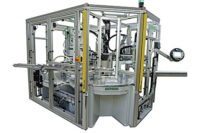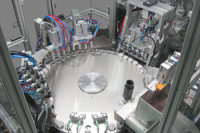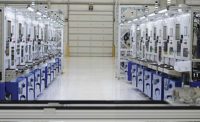Due to the rising cost of brass, and more importantly, concern about contamination from nonferrous metals in drinking water systems, a North American supplier of plumbing products developed a new valve that has no metal parts and performs as well or better than brass valves.
The new valve is made from polysulfone and ceramic instead of brass. The supplier wanted to produce 4 million to 6 million valves per year at Six Sigma quality levels.
Due to the high labor-content of the assembly, this valve was originally slated for production in China. However, although the piece price met the supplier’s cost requirement, concerns arose regarding consistent quality using a manual assembly process. On the other hand, automated assembly was considered too complex to be viable. The valve assembly included delicate ceramic discs and rubber O-rings that might be difficult to assemble with automation.
Hoping to assemble the valve domestically, the supplier contacted contract manufacturer Advanced Molding Technologies LLC in Circle Pines, MN. Certified to ISO 9001:2008 (overall quality management) and ISO 13485:2003 (medical device quality management) standards, Advanced has more than 83,000 square feet of space devoted to plastic injection molding, decoration, assembly and packaging. Some two-thirds of Advanced’s sales come from selling custom-made plastic parts to the medical-device industry, and the company has more than 6,000 square feet of clean room space. Advanced also does business in the automotive and consumer products industries.
To assemble the valve, Advanced’s engineers came up with a fully automated system based on a 10-station rotary indexing dial. At more than $1 million, the cost of the automation project was substantial. However, the projected payback would be realized in just two years of production (vs. assembling the valve with low-cost labor in China). With the added benefit of much more consistent parts, the supplier entrusted Advanced with building the automation cell to produce the valve in the U.S.
Advanced’s engineers researched many automation processes and evaluated several automation specialists before creating their own design concept. To ensure the overall success of the project, a comprehensive failure modes and effects analysis was performed to foresee potential problems once the system was completed.
All totaled, the assembly process for the valve would have 18 steps. Advanced’s engineers designed each step in the process and even built working “proof of concept” benchtop models for many of the stations. Once everything was validated, the assembly system was built over a six-month period.
At the first two stations, the valve housing is loaded into a fixture and engraved with a laser. Next, a pick-and-place unit installs one O-ring at the bottom of the housing and another on the fixture.
At the fourth station, a vision-guided SCARA robot installs three ceramic disks—two thin ones and one thick one—into the housing. Both disks are fed to the pick point on a single low-profile, flat-belt conveyor. The belt is black to improve contrast for the vision system.
At the fifth station, a pick-and-place unit installs the O-ring from the fixture into the housing. At the next two stations, a cap is placed onto the valve and tightened with a rotary actuator. Then, an on-off switch is snapped into place to complete the assembly.
At the last station, the valve is off-loaded to an indexing conveyor. From there, the valves undergo a pressure-decay leak test (two at a time) and are packaged with additional components.
The assembly system’s production rate exceeded expectations, producing virtually 100 percent defect-free parts. The system produces a fully kitted and tested valve every 6 seconds. In the end, the final manufacturing costs came in at one-third the cost of producing the same part with low-cost labor in China, resulting in a payback time of less than 1.5 years.
To see a video of the cell in operation, visit http://tinyurl.com/p79dg3o.
For more information on molding, assembly and packaging services, call Advanced Molding Technologies at 763-785-9229 or visit www.advancedmt.com.
Editor’s note: Whether you’re a systems integrator or the in-house automation team of an OEM, if you’ve designed a system that you’re particularly proud of, tell us about it. Send an e-mail to John Sprovieri, editor of ASSEMBLY, at sprovierij@bnpmedia.com, or call 630-694-4012.





